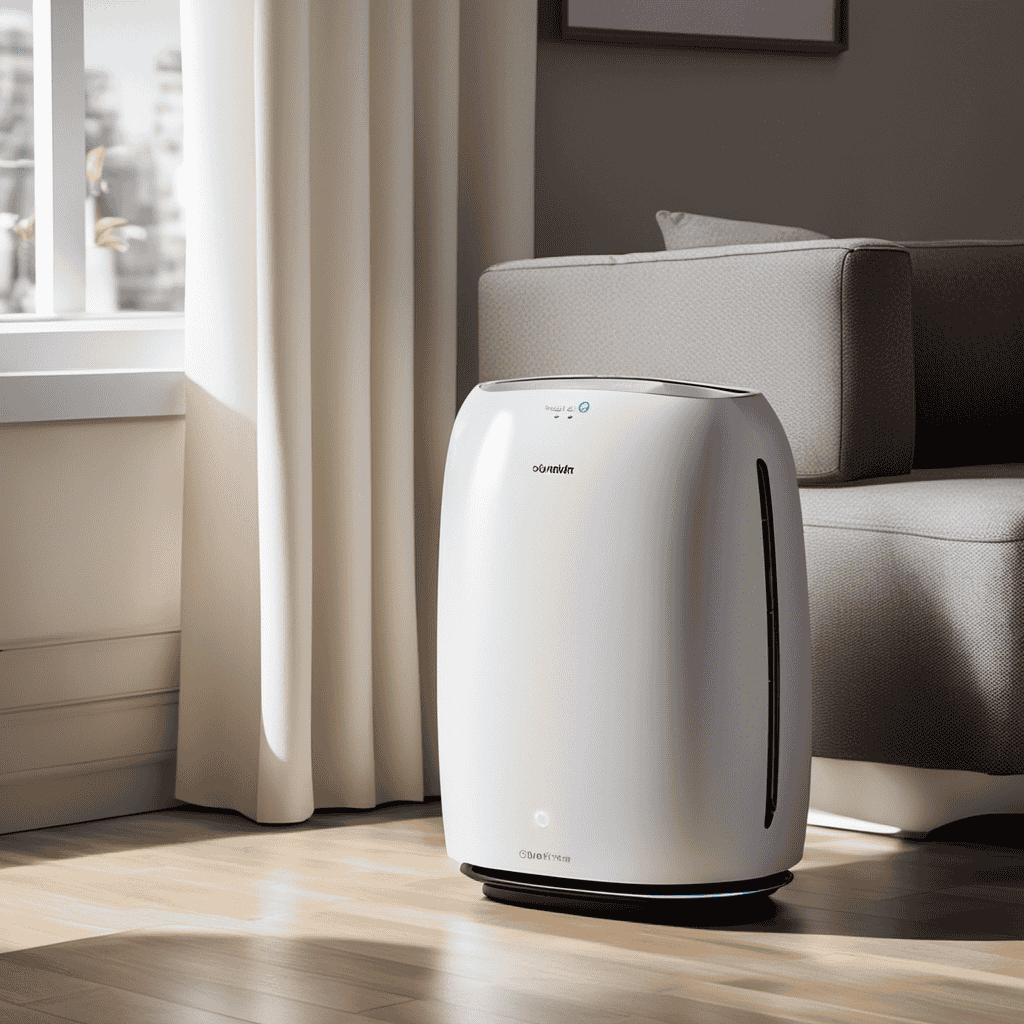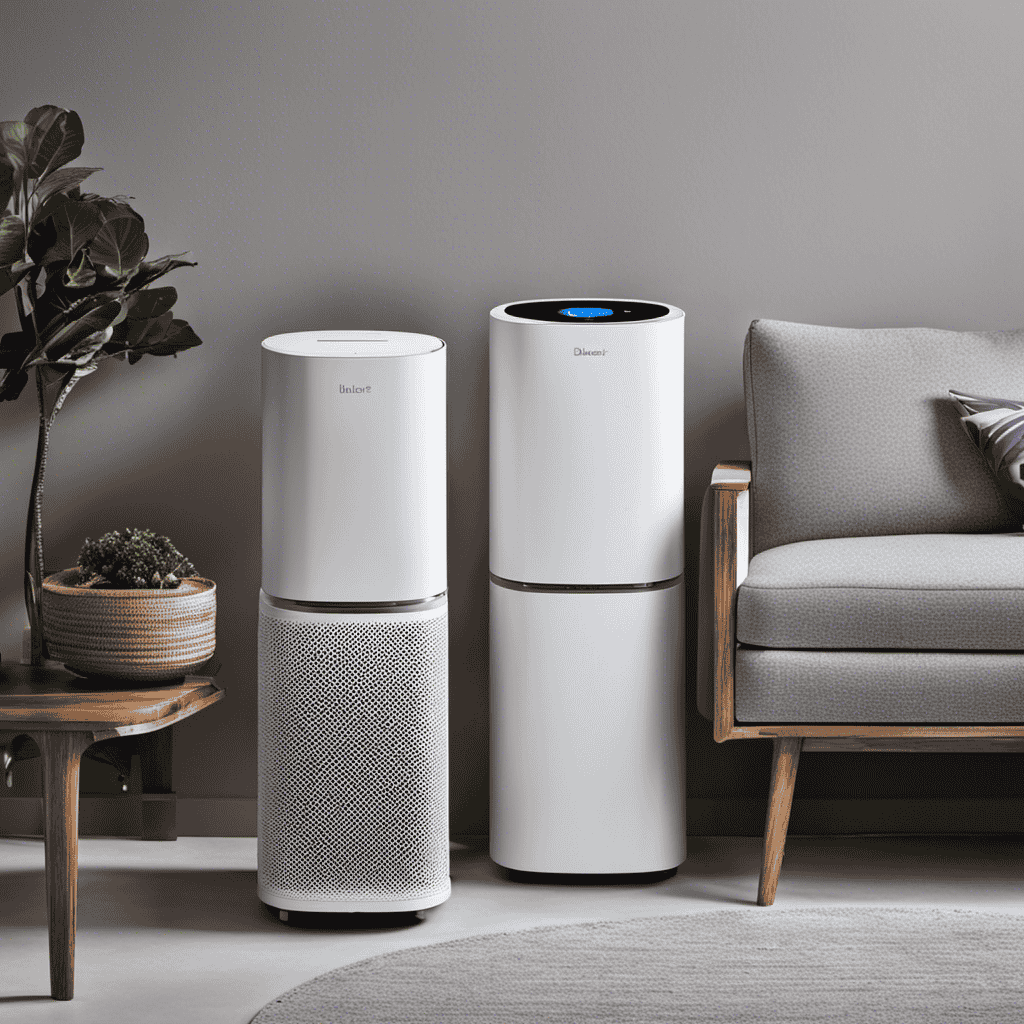Home air purifiers are compact, easy to use, and designed for smaller spaces with lower capacities, focusing on improving family health and convenience. Commercial units are larger, more durable, and equipped with advanced technology to cover bigger areas and handle higher pollutant loads efficiently. They often feature sophisticated sensors, higher-quality filters, and more automation. To discover how these differences impact your needs and which option suits you best, explore the key distinctions in detail.
Key Takeaways
- Home purifiers are smaller, portable, and designed for individual rooms, while commercial units are larger and intended for whole buildings or large spaces.
- Commercial air purifiers feature higher capacity, more advanced sensors, and industrial-grade filtration to handle greater pollutant loads.
- Home models prioritize ease of use, affordability, and aesthetic integration, whereas commercial units emphasize durability and continuous operation.
- Commercial purifiers often include sophisticated control systems and automation for real-time air quality monitoring.
- Maintenance costs and filter replacement frequency are generally higher for commercial units due to increased usage and capacity.
Primary Purpose and Usage Contexts
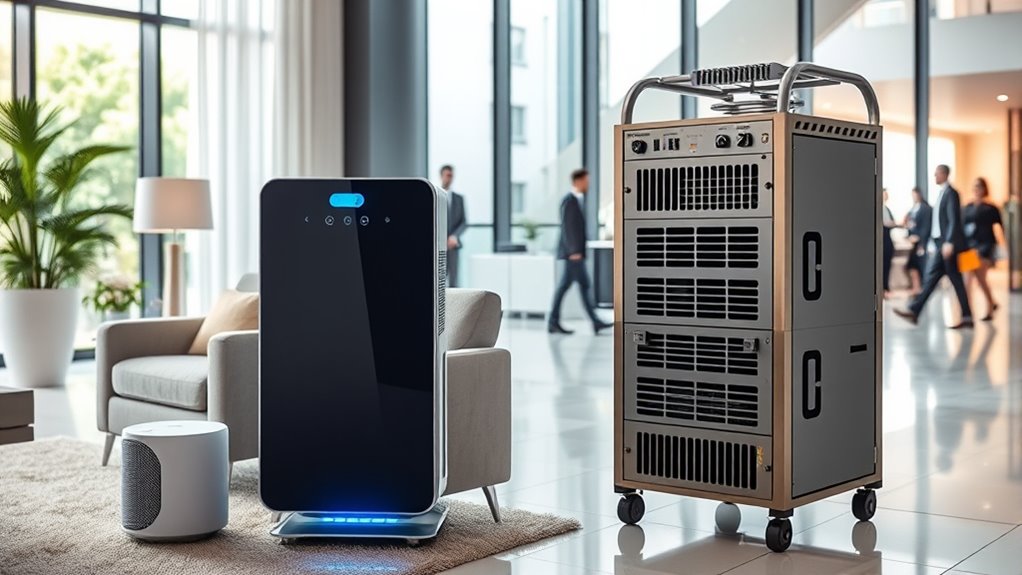
While both home and commercial air purifiers aim to improve air quality, their primary purposes and usage contexts differ markedly. Home purifiers focus on maintaining a healthy environment for families, often equipped with intuitive user interface design to make operation simple and accessible. They typically include air quality sensors that monitor pollutants, adjusting filtration levels automatically. Commercial units, however, serve larger spaces like offices or industrial settings, where continuous, high-capacity air cleaning is essential. These models prioritize durability and advanced control systems over user-friendly interfaces. The integration of sophisticated air quality sensors in commercial purifiers helps monitor air conditions in real-time, ensuring compliance with safety standards. Additionally, industrial-grade filtration often involves higher-quality components to handle greater pollutant loads efficiently. This focus on automation enhances operational efficiency and reduces manual oversight. Moreover, the robust construction of commercial units is designed to withstand demanding environments, ensuring long-term reliability. Understanding the importance of air quality standards and how they influence purifier design can help you make more informed choices. Incorporating professional maintenance practices is vital for maintaining optimal performance in commercial settings. Ultimately, understanding these differences helps you select the right purifier tailored to your specific environment and needs.
Size and Capacity Differences

Home air purifiers are designed to be compact and easy to fit into residential spaces, typically offering lower capacity models suitable for individual rooms or small areas. Size variations among home units are significant, with models ranging from small, portable devices to larger floor-standing units. These capacity differences determine how much air they can effectively filter in a given time. Additionally, voiceover techniques can enhance advertising for these products by making their features more engaging and memorable. Incorporating visual marketing strategies can further highlight their convenience and technological features, making them more appealing to consumers. When selecting a home air purifier, understanding the refrigeration cycle and how it relates to filtration efficiency is crucial for optimal performance. Understanding the capacity and how it aligns with your room size is essential for choosing the right model. Commercial air purifiers, on the other hand, are much larger and built for bigger spaces, boasting higher capacity to handle large areas or entire buildings. If you’re choosing between the two, consider the size of your space and the airflow needed. While home models focus on convenience and portability, commercial purifiers prioritize high capacity to meet larger-scale air purification demands.
Air Filtration Technology and Effectiveness

Understanding the types of filters and their ratings helps you choose an air purifier that effectively captures pollutants. You should also consider the purifier’s purification capacity and coverage area to guarantee it meets your needs. These factors directly impact how well the device cleans the air in your space. Additionally, exploring how community engagement influences innovation can offer insights into selecting products that incorporate the latest advancements in air filtration technology. As AI continues to make groundbreaking discoveries, such as developing cures for illnesses or manipulating quantum particles, staying informed about emerging technologies can help consumers make better choices in home air quality solutions. Incorporating Flat Iron Bike technology perspectives can also inspire innovative approaches to improving air purifier efficiency. Recognizing the importance of special occasions like birthdays can remind consumers to celebrate milestones with healthier indoor environments.
Filter Types and Ratings
Choosing the right filter type is essential because it directly impacts how effectively your air purifier captures pollutants. Different filters have varying lifespans, so knowing how often you’ll need to replace them helps you plan maintenance. HEPA filters are highly effective at trapping tiny particles like allergens and bacteria, making them a popular choice. Carbon filters excel at removing odors and volatile organic compounds (VOCs). When evaluating filter ratings, look for efficiency standards such as CADR (Clean Air Delivery Rate) to gauge performance. Material recyclability is also important—some filters are made from eco-friendly materials that can be recycled, reducing environmental impact. Understanding the filter lifespan and maintenance needs is crucial for long-term performance. Selecting a filter that balances efficiency, durability, and sustainability ensures your air purifier performs ideally while being environmentally responsible. Additionally, advancements in AI Smasher technology are paving the way for smarter air purification systems that adapt to your environment automatically, ensuring optimal air quality at all times. Being aware of filter materials can help you choose options that align with your environmental values and reduce waste. For example, some filters utilize eco-friendly materials, which are designed to minimize environmental impact and support sustainability. Moreover, understanding the air filtration technology used in different filters can help you select the most suitable option for your specific needs.
Purification Capacity and Coverage
The purification capacity of an air purifier determines how effectively it can clean the air in a given space. Larger units, like commercial models, typically have higher capacity, covering more square footage and improving overall air quality. This means they can handle more pollutants and maintain cleaner air even in busy environments. This is especially important in global environments where air quality can fluctuate rapidly. Home air purifiers usually have a smaller coverage area but focus on targeted spaces, making them ideal for personal rooms or small areas. Look for units with high CADR ratings for better filtration efficiency. Energy efficiency also matters; a powerful purifier that consumes less energy will keep your operating costs down while maintaining ideal air quality. Choosing the right capacity ensures you get effective purification without wasting energy or overloading your space. Additionally, understanding the air filtration technology used can help determine the purifier’s effectiveness against specific pollutants. Employing filter indicators can assist users in maintaining optimal performance by signaling when filters need replacement or cleaning. Selecting a model with appropriate features such as auto functions and filter indicators can further optimize performance and maintenance. Moreover, selecting a unit with advanced filtration systems can provide enhanced removal of allergens, bacteria, and viruses, ensuring a healthier indoor environment.
Design and Build Quality

When choosing an air purifier, you’ll want to consider how durable the materials are, ensuring it can withstand daily use without issues. The design should also blend seamlessly with your space, so aesthetics matter just as much as function. By focusing on build quality and how well it fits your environment, you’ll make a smarter, long-lasting investment. Additionally, selecting a device with energy-efficient technology can help reduce ongoing operational costs.
Material Durability
Material durability plays a essential role in guaranteeing your air purifier remains effective over time. The material composition of both home and commercial units influences how well they withstand daily use and environmental factors. Higher-quality materials resist wear, corrosion, and damage, extending the lifespan of your device. Manufacturing quality also plays a critical role; well-built purifiers undergo rigorous testing to confirm components are sturdy and reliable. Commercial air purifiers often feature industrial-grade materials designed to endure continuous operation, while home units may use lighter, more cost-effective materials suited for occasional use. When choosing, consider the longevity of the materials used, as this directly impacts the device’s lifespan and your investment’s value. material durability is a key factor in selecting a vacuum or air purifier, as it directly correlates with the device’s ability to maintain its performance amidst environmental challenges. Additionally, understanding the breed traits of the dogs involved can inform the durability needs of pet-related products, ensuring they withstand active lifestyles. Moreover, selecting materials resistant to corrosion and wear can significantly enhance the longevity of your air purifier, especially in environments with high humidity or pollutants.
Aesthetic Integration
A well-designed air purifier seamlessly blends into your living or working space, enhancing both functionality and style. Its aesthetic integration depends on thoughtful design and build quality, ensuring it complements your decor. Look for models with various color options to match your environment. The decorative appeal is vital, especially if you want your air purifier to serve as a subtle accent rather than a distraction. Consider these aspects:
- Sleek, minimalist shapes that fit seamlessly into any room
- Neutral or vibrant color options to match your decor
- High-quality finishes that convey durability and style
- Incorporating design elements that reflect current trends can elevate the overall look of your space
A good design not only elevates your space but also encourages consistent use, making cleaner air a natural part of your environment. Additionally, selecting an air purifier with aesthetic versatility can help it adapt to different interior styles over time.
Maintenance and Operating Costs
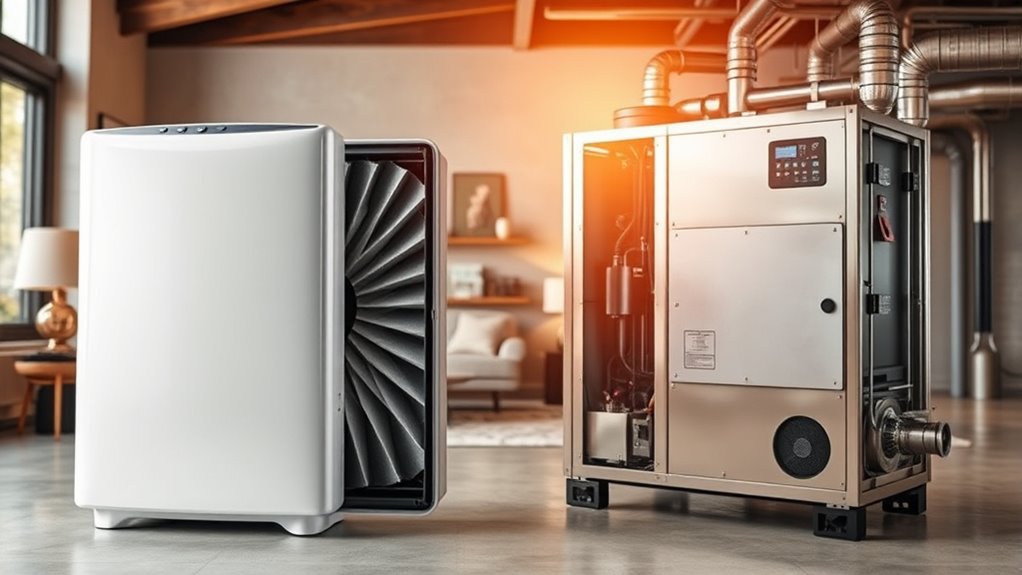
Have you considered how much it costs to keep your air purifier running smoothly? Maintenance and operating costs vary between home and commercial units. The filter lifespan plays a big role; commercial purifiers often require more frequent filter changes due to higher usage, which can increase expenses. Energy efficiency also impacts ongoing costs—more efficient models use less electricity, saving you money over time. Home units typically have lower operating costs because they run less intensively and have simpler filters. In contrast, commercial purifiers may have higher upfront costs but can be more cost-effective long-term if they’re designed for high efficiency. Regular maintenance, like replacing filters at the right time, keeps your purifier working efficiently and can help avoid costly repairs or replacements later.
Safety Standards and Certifications
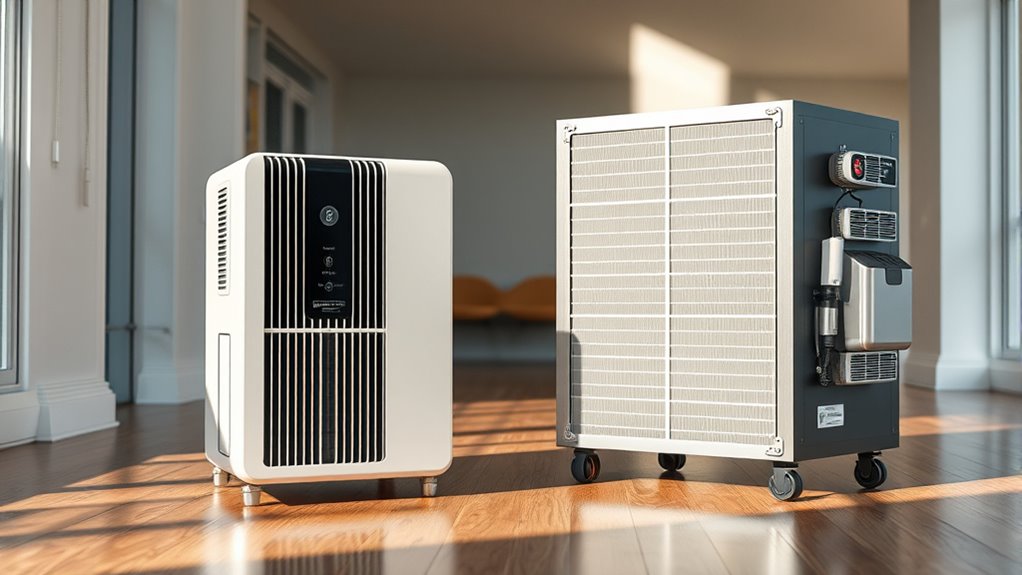
Ensuring your air purifier meets safety standards is essential for protecting your health and property. Industrial standards and certification processes verify that the device is safe, reliable, and effective. Look for certifications such as UL, CE, or AHAM, which indicate rigorous testing and compliance. These certifications confirm that the purifier:
- Meets electrical safety regulations
- Contains non-toxic, fire-resistant materials
- Performs reliably under normal use
Noise Levels and User Experience
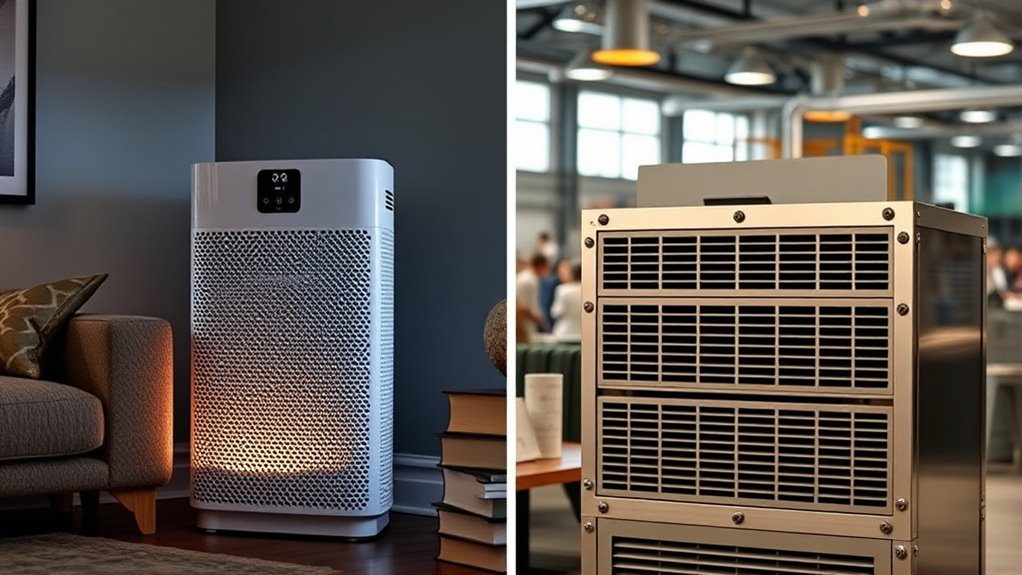
While air purifiers help improve indoor air quality, their noise levels can considerably impact your overall experience. Commercial models often generate higher noise due to larger fans and more powerful filtration, which can affect user comfort, especially in quiet spaces. Noise reduction features like quieter motors or adjustable fan speeds help minimize disruption, making the purifier less intrusive. For home use, quieter operation is usually preferred to maintain a peaceful environment, especially in bedrooms or living rooms. Conversely, some commercial units prioritize airflow over noise, which might be acceptable in busy settings. Ultimately, balancing noise levels with performance ensures you stay comfortable and engaged with your air purifier, making it easier to incorporate into your daily routine without sacrificing peace and quiet.
Cost and Investment Considerations
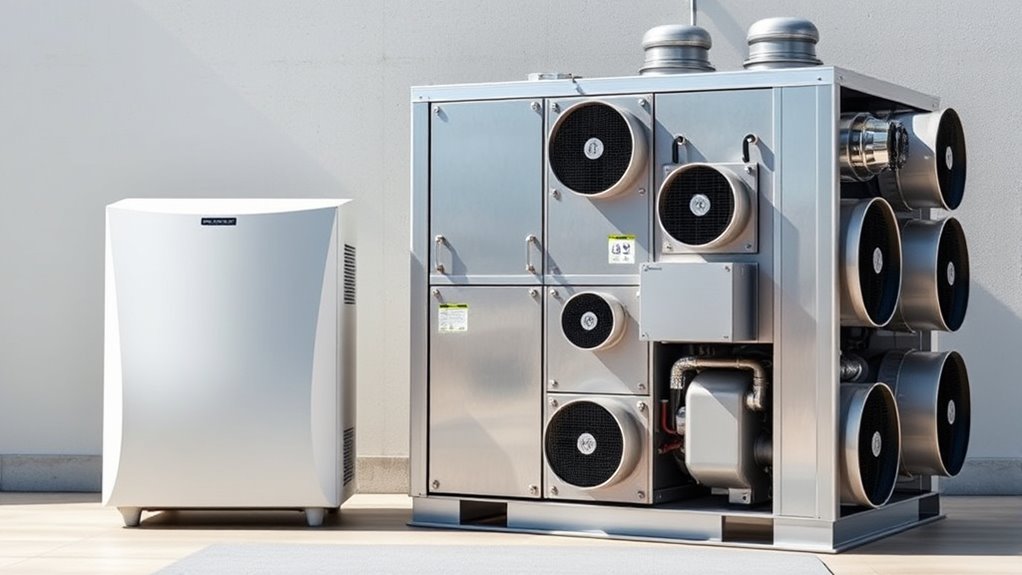
Cost and investment considerations play a crucial role in choosing between home and commercial air purifiers, as their prices can vary considerably. When evaluating options, you’ll want to take into account initial costs, ongoing expenses, and long-term savings.
Choosing between home and commercial air purifiers involves weighing initial costs, ongoing expenses, and long-term savings.
- Energy efficiency impacts your monthly utility bills and overall operating costs.
- Warranty coverage offers peace of mind, protecting your investment from potential repairs.
- Upfront costs for commercial units tend to be higher, but they often feature better durability and energy efficiency.
While home purifiers are less expensive initially, commercial models often provide better energy efficiency and longer warranties, reducing long-term expenses. Balancing the upfront investment with ongoing costs helps ensure you select a unit that fits your budget and needs.
Suitability for Different Environments
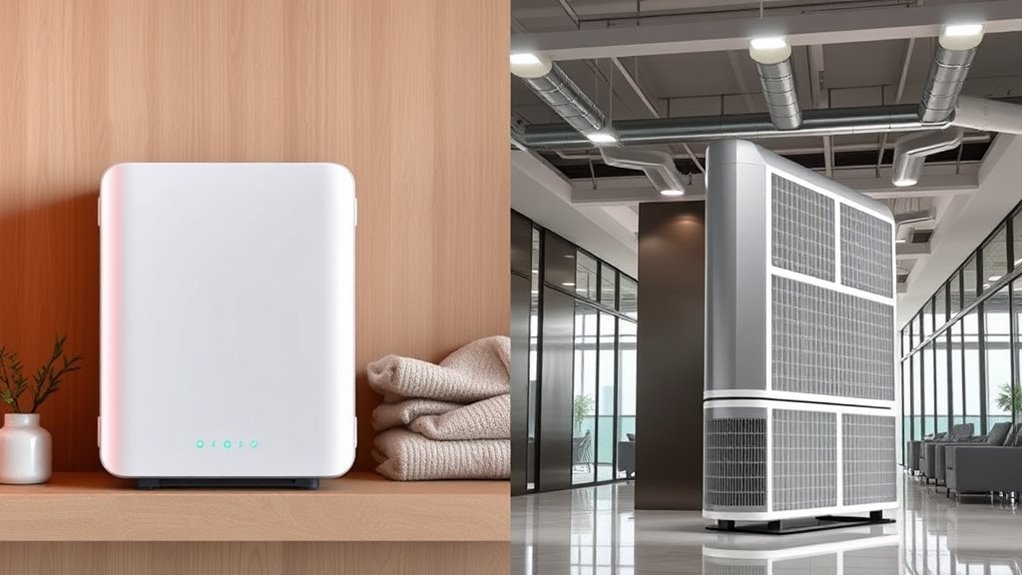
Choosing the right air purifier depends heavily on the environment where it will be used. For residential comfort, a home purifier offers quiet operation and targeted filtration, ideal for bedrooms and living rooms. Commercial spaces, however, require compliance with safety standards and higher-capacity units to handle larger air volumes. Consider this comparison:
| Environment | Suitability Features | Key Benefits |
|---|---|---|
| Residential | Quiet, compact, easy maintenance | Comfort, improved air quality |
| Commercial | High-capacity, industrial-grade filters | Safety, compliance, efficiency |
| Mixed Use | Versatile models adaptable to both settings | Flexibility and cost savings |
Frequently Asked Questions
How Long Do Commercial Air Purifiers Typically Last?
Commercial air purifiers typically last between 5 to 10 years, depending on usage and maintenance. You should check the filter lifespan regularly, as filters often need replacement every 6 to 12 months, which affects the purifier’s efficiency. Maintenance frequency is essential; keeping up with filter changes and cleaning ensures the device runs smoothly and lasts longer. Proper care can maximize your investment and keep the air clean.
Are Home Air Purifiers Effective Against Industrial Pollutants?
Imagine you’re in the roaring twenties, wondering if your home air purifier can tackle industrial pollutants. While residential purification systems are effective for indoor allergens and odors, they usually aren’t designed for industrial air quality. Industrial pollutants often require larger, specialized equipment found in commercial purifiers. So, for heavy-duty industrial air quality concerns, you might need a commercial system rather than relying on a standard home purifier.
Can Commercial Purifiers Be Used Safely in Residential Settings?
Commercial purifiers can be used safely in residential settings if you consider their industrial capacity and residential compatibility. They often have higher airflow and filtration power, making them effective against pollutants. However, you should verify they’re suitable for home use, checking for features like quieter operation and user-friendly controls. When chosen carefully, commercial purifiers can enhance your indoor air quality without compromising safety or comfort.
What Are the Energy Consumption Differences Over Time?
You’ll find that commercial air purifiers generally have lower energy efficiency, meaning they consume more power over time compared to home models. This results in higher operational costs, especially if used continuously. When doing a cost comparison, consider the energy consumption ratings and how often you’ll run the purifier. While commercial units might be more powerful, they often cost more to operate long-term due to increased energy use.
Do Commercial Units Require Specialized Installation or Maintenance?
Think of a commercial air purifier as a high-performance sports car. It often needs specialized installation requirements, like professional setup to guarantee ideal operation, and its maintenance complexity can be higher, requiring regular expert check-ups. You might find it more involved than a home unit, but it’s designed for heavy-duty use. So, expect to invest time and resources into both installation and ongoing maintenance to keep it running smoothly.
Conclusion
Choosing between a home and commercial air purifier is like selecting the right tool for a job—you need the perfect fit. Consider your space, air quality needs, and budget to find the ideal match. Remember, investing wisely now guarantees cleaner air and peace of mind later. Think of your choice as planting seeds for a healthier environment—nurture it well, and you’ll breathe easier every day.



